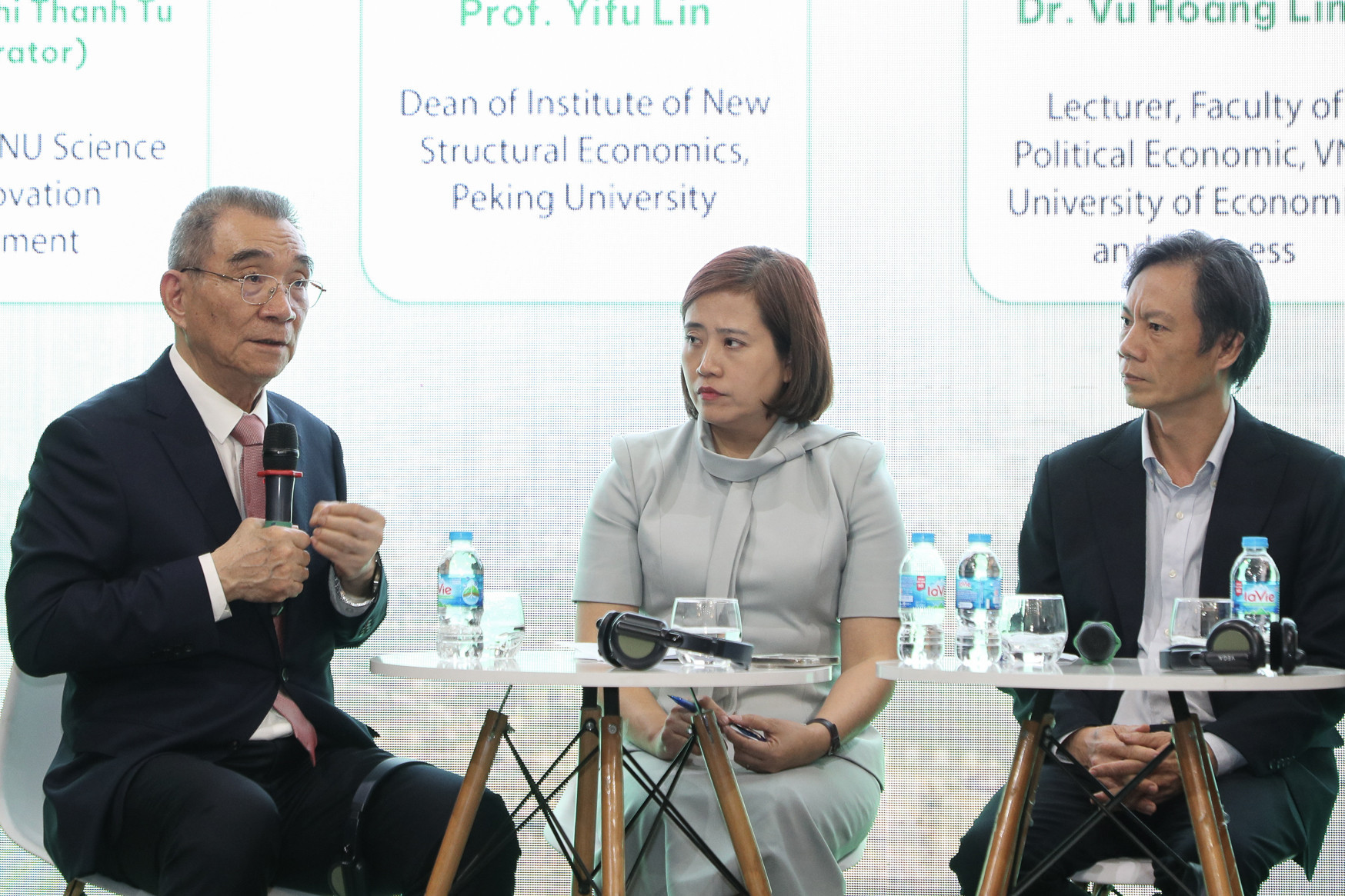VietNamNet is pleased to present the continuation of insights from Professor Lin Yifu, a leading Chinese economist, at the academic forum “Prosperous Vietnam in the New Era” recently hosted by Vietnam National University.
New Structural Economics: A roadmap for transformation

The New Structural Economics, proposed and developed by Professor Lin Yifu, offers a theoretical framework for developing countries aiming to upgrade their industries and comprehensively restructure their economies.
According to this theory, each country possesses distinct advantages in capital, human resources, or natural assets. Therefore, the industrial comparative advantages of each nation vary at different points in time.
The key to sustainable growth lies in fully utilizing and upgrading these inherent advantages. Countries must transform promising sectors into globally competitive industries, enabling domestic enterprises to continually learn, master advanced technologies, and expand.
Comparative advantage exists when a country can produce goods at lower cost and higher efficiency than others. Strengthening hard and soft infrastructure and implementing effective industrial policies are essential to reduce production costs and enhance global competitiveness.
The state must play a strategic and supportive role in helping businesses increase production capacity, adopt advanced technologies, and gradually move into higher-value segments of global supply chains. This approach enables economies to shift from reliance on raw resources and cheap labor to modern, technology-driven production systems.
“To achieve high growth, continuous industrial and technological upgrading is essential. This depends heavily on the economic structure,” he emphasized.
“An economy based on capital and cheap labor must maximize endogenous capabilities in order to compete in high-income markets,” he added.
China’s path as a model
Professor Lin noted that both China (1978–1980) and Vietnam (late 1980s–1990s) launched timely reforms to restructure their economies. When governments adhered to market principles while actively supporting the transformation of latent comparative advantages into real competitiveness, domestic enterprises flourished.
In China's case, success stemmed from policies that promoted technology adoption, learning, and transfer. This enabled the country to progressively master core production technologies.
In contrast, many countries failed to escape the middle-income trap due to stagnant economic structures. Instead of evolving toward high-value industries, they clung to labor-intensive sectors.
What, then, is the strategy for developing industries based on comparative advantage? Lin’s answer: potential lies in both hard and soft infrastructure. A globally competitive economy must achieve optimal production efficiency and ownership structure.
A developing country must also seize the “latecomer advantage” – the ability to learn and adopt technologies from high-income nations. A strong partnership between government and business is essential.
Price mechanisms, market competition, and product diversification all require state support. Pioneering enterprises need coordinated public investment in hard and soft infrastructure. Thus, the state must support leading firms with legal frameworks, infrastructure, and a fair market environment.
Legal frameworks should be updated to foster business development. Successful nations not only build market economies but also empower the state to play an active and strategic role. The state must serve as the “architect” of economic restructuring.
Given limited resources, investments must focus on high-potential sectors, transforming them into competitive industries and maximizing efficiency.
“Why do I emphasize the state's role in enhancing competitiveness?” Lin asked. Reflecting on China’s 1970s–1980s economic debates, he recalled economists questioning state investments in sectors lacking financial resources or strategic advantage. Such missteps led to failure. Meanwhile, some advanced economies failed due to small domestic markets that couldn't support scaling.
Industrial policy misalignment can lead to lifeless domestic enterprises, soaring production costs, and unsustainable, state-dependent companies that falter when protections are removed.
Advice for Vietnam

As a latecomer, Vietnam has the opportunity to select sectors with real competitive advantages and adopt global technologies.
Professor Lin outlined five key sector groups: high-value-added industries, global-leading sectors, declining comparative advantage sectors (like cheap labor), and leapfrogging sectors such as artificial intelligence and big data.
With its 100 million population and abundant talent, Vietnam must harness this workforce to enter leapfrogging industries and rise on the global economic stage.
The private sector's role is vital. The government must support private enterprises entering strategic industries and eliminate barriers.
In sectors where domestic firms have yet to emerge, Vietnam should attract foreign direct investment (FDI) from developed countries to incubate and inspire local businesses. The government should also facilitate the development of the private sector and encourage organic growth.
In underdeveloped industries, capital and technology transfer via FDI is crucial for breakthroughs. The state must enhance infrastructure and channel domestic investment into priority sectors.
Governments should also consider offering credit for strategic sector investments.
Equally important, Vietnam needs policies to help businesses exit low-value, labor-intensive sectors. For example, workers in Hanoi or Ho Chi Minh City could be retrained for higher-value roles.
New technologies offer Vietnam a competitive edge, thanks to its large population and diverse education system. Investment in human capital through education is a key strategy.
Vietnam’s education system is already approaching the standards of developed nations. A well-trained workforce will become a national competitive advantage.
For strategic sectors tied to national security and localization, government financial support may also be necessary.
In summary, Professor Lin emphasized that Vietnam must boost labor productivity and reduce labor costs. The path to catching up with developed nations lies in growing the private sector, embracing innovation, upgrading industries, and reforming institutions. To close the gap and accelerate growth, Vietnam should import and acquire patents and technologies to catch up - and potentially overtake - advanced economies.
“If Vietnam can capitalize on these advantages, its economic growth will far exceed expectations. That’s how other countries have successfully developed,” he concluded.
Tu Giang